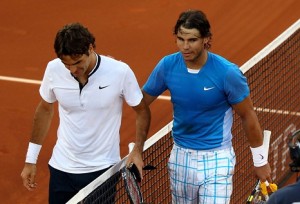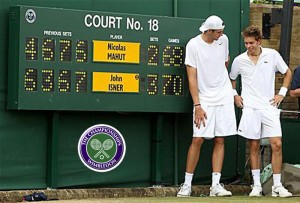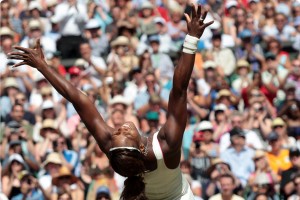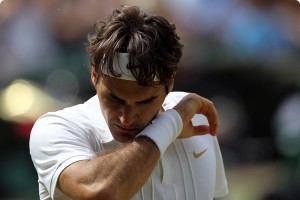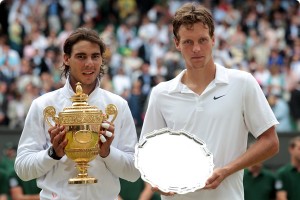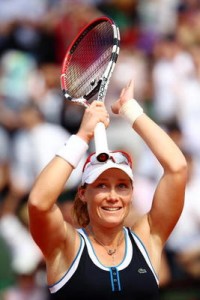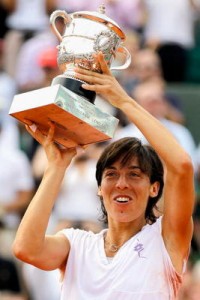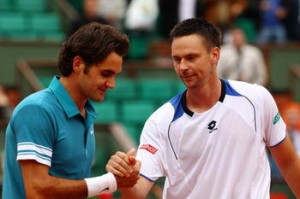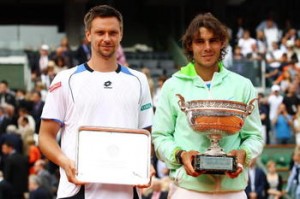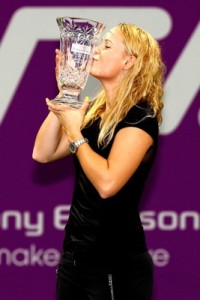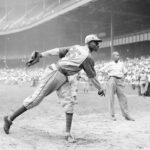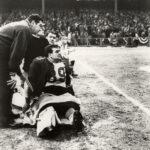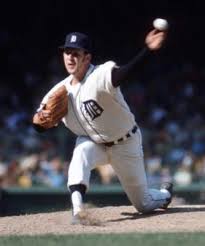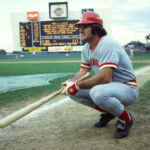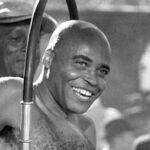Ranking Tennis in 2010: The Top 10 Performances, Part 1
2010 proved to be an exceptional year in tennis, as the No. 1 mantle changed owners in the men’s and the women’s game.
Roger Federer and Serena Williams who both entered 2010 ranked No. 1 dropped out of the top spot.
Roger will end the year with the No. 2 ATP ranking while Serena will end her year as No. 4 in the WTA.
But many significant performances––some for a match and some for a season––shaped a very controversial, entertaining year on the tennis courts of the world.
The ranking of these respective performances is subject to interpretation. Perhaps even attempting to put them in any particular order is a waste of time.
Regardless, all 10 are significant in assigning superlatives to the 2010 season.
Preamble: A Toast To the 2010 Tennis Match That Refused To Die
John Isner defeats Nicholas Mahut, first round, 2010 Wimbledon
Normally a first round match is nothing more than a formality for seeded players during a grand slam––but not always.
A case in point––American John Isner seeded No. 23 had little expectation concerning the full-scope of this match as he met his opponent Frenchman Nicholas Mahut on Court 18 to contest this opening round match.
The match, however, extended over three days lasting 11 hours, five minutes, and ended at 70-68 in the fifth and final set.
Wimbledon, you see, does not allow for a tiebreak to determine a winner if the match extends to five sets.
After this epic, there was a concern expressed regarding this tradition because these two players suffered physically for a long while after the match concluded.
The world became mesmerized by this drama unfolding daily on an obscure outside court at the All-England Club.
In fact, the match drew vast numbers to watch––people who otherwise would not have spent a moment of their busy lives watching tennis.
Therefore, the networks, and in this case ESPN, loved it.
No. 10: Serena Williams Punctuates Slam No. 13
Serena Williams vs. Vera Zvonareva, 2010 Wimbledon Final
2010 was the season for Vera Zvonareva whose ankle injury and subsequent surgery in 2009 kept her down.
But Wimbledon in 2010 became her stage and she quickly announced to all assembled a return to the form that secured her the No. 5 ranking in 2009.
Prior to this tournament, the Russian had never progressed past the fourth round.
The prospect of facing World No. 1 Serena Williams in the final, however, had to accentuate the fragile nervous state of the often melt-down-queen, Zvonareva.
Serena Williams had never faced the Russian on grass. But this day with the American serving well and pinpointing her ground strokes long and deep, Zvonareva never found her way into the match as Williams won 6-3, 6-2 in 67 minutes.
The American broke the Russian’s serve three times and never faced a break point on her own serve.
The match served as the culminating event demonstrating the total dominance of the World No. 1 who won Wimbledon without dropping a set.
Williams set a record at Wimbledon for serving the most aces in a grand slam with 89 in 2010.
It was the younger Williams sister’s fourth Wimbledon crown giving her back to back wins in 2009-2010.
Williams also won her 13th grand slam, sending her past Billie Jean King on the list of multiple winners. Serena Williams sits behind Martina Navratilova and Chris Evert both at 18, Helen Wills Moody at 19, Steffi Graf at 22 and finally Margaret Court at 24.
The nearest active players are sister Venus Williams and Justine Henin at seven.
Shortly after Wimbledon, however, Serena Williams stepped on broken glass, severely injuring her foot. After subsequent surgery, Williams missed the rest of the season, lost her No. 1 ranking and will, according to reports, miss the upcoming Australian Open.
No. 9: The Czech Berdych Serves Notice On the Top 2
Thomas Berdych vs. Roger Federer, 2010 Wimbledon
At the French Open, it was Robin Soderling who stepped forward to challenge the top two ranked players in their quest for another grand slam championship.
At Wimbledon, it was Czech Tomas Berdych who did his best to derail the stranglehold of Federer and Nadal on grand slam championships.
Federer was hoping to win his seventh Wimbledon crown while Nadal aspired to his second Wimbledon championship.
Berdych after winning his first two matches at the All England Club in straight sets barely survived Denis Istomin of Uzbekistan in five sets 6-7, 7-6, 6-7, 6-3, 6-4.
The Czech’s fourth round victory over Daniel Brands of Germany 4-6, 7-6, 7-5, 6-3 set up a quarterfinal match-up with the No. 1 seed, Roger Federer, defending champion.
Federer, whose level of play after the Australian Open took a swan dive, found himself across the net from the tournament’s soon-to-be hottest player.
The two had met 10 times with Berdych winning twice––shocking Federer in the early rounds at the 2004 Olympics in Athens and then again as recently as the 2010 ATP Masters Tournament in Miami.
Federer had defeated Berdych twice on grass prior to this quarterfinal match-up.
On this day, there was no magical come back for the six-time champion as Berdych continued to power past the Swiss serving extremely well and hitting his ground strokes with power and depth.
The unrelenting pressure applied by Berdych resulted in his best win to date over Federer on the lawns of Wimbledon––Federer’s favorite surface.
The match, which lasted about two and a half hours, ended when Berdych delivered another forehand winner to take the match 6-4, 3-6, 6-1, 6-4.
Even though there were some tense moments for Berdych in the closing moments of the fourth set, the Czech held his nerve and sent Federer home early, failing to reach the finals for the first time since 2002.
From 2003 through 2009 Federer had presented himself on Centre Court for every gentleman’s singles final.
Thomas Berdych vs. Rafael Nadal, 2010 Wimbledon
In 2010 it would be Tomas Berdych who would face the World No. 1 Rafael Nadal on Centre Court for the men’s final.
After Berdych dispatched his semifinal opponent Novak Djokovic 6-3, 7-6, 6-3 and Nadal turned away Andy Murray 6-4, 7-6, 6-4, the final was set.
Head to head before the final the advantage went to Nadal 7-3.
The final was anticlimactic as many of them are when an underdog finally arrives on the largest stage of them all.
There was no fire nor assurance for Berdych on the day as Nadal quickly and methodically convinced the Czech to fold his tent and go home.
Nadal did everything needed to win convincingly.
That had to be a relief for the Majorcan after his last final on Centre Court in 2008––the massive five-set marathon with Roger Federer that some hail as the greatest tennis match of all time.
The Majorcan defeated Berdych 6-3, 7-5, 6-4 in two hours and 13 minutes with no drama or furor.
For Berdych, it was the moment and more importantly, the competitor who gave the Czech no leverage to gain a foothold in the match.
Nadal swept up his eighth grand slam title and his second consecutive slam title of 2010, having recaptured the French in June.
All eyes now turned toward New York and Flushing Meadows and the U.S. Open where Nadal had never made the finals.
No. 8: Changing of the Guard As an Aussie and an Italian Storm Roland Garros
Samantha Stosur defeated Serena Williams 2010 French Open Quarterfinal:
Most favored Serena Williams to win the 2010 French Open, especially after Aussie Samantha Stosur dispatched Justine Henin in the fourth round.
In fact some pondered the possibility of the youngest Williams sisters winning all four slams in the 2010 calendar year.
Stosur, who was known more for her doubles career than her singles prowess, found herself across the net from the World No. 1, knowing she absolutely had a chance to win this match.
Clay, after all, was never one of Serena Williams’ favorite surfaces.
Stosur stormed out to an impressive lead, winning the first 17 points of the match. The Aussie broke the American’s serve twice and took the first set 6-2.
Then, undeterred, Stosur took a 5-3 lead in the second set. Williams was set back on her heels trying to keep pace with power and depth of Stosur’s shots.
The thought of winning, however, undid Stosur and she began to play tentatively––not to lose rather than going for her shots as she had to that point.
The Aussie lost the second set as Williams broke back evening the score and sending the second set to a tiebreak. Williams had found her footing and her serve once again.
When Williams held a match point as she went up 30-40 on Stosur’s serve, everyone assumed that the tide had turned and the American would win the match.
Everyone, that is, except Stosur. The Aussie fought back to 5-5 and the match progressed to 6-6. But there was no tie-break in the third set at the French Open and two played on.
Williams double-faulted her service game away giving the Aussie the lead and eventually the set and the match.
In the end Stosur did not fold under pressure and lived to play on in the final after defeating another former No. 1 Jelena Jankovic in the semifinals.
The win over Serena Williams ushered in a new era for Stosur who rose in ranking into the top eight in the WTA.
Francesca Schiavone defeats Samantha Stosur: 2010 French Open Final:
This was supposed to be the tournament for the return to glory of Justine Henin. It had always been the Belgian’s best tournament, having won the title four times previously.
This seemed especially likely after Henin’s success at the Australian Open earlier in 2010 by making the finals even if she lost in three sets to Serena Williams.
But this was not the year for Henin. Nor was it the year for the Williams sisters.
Henin as well as Serena Williams lost to Samantha Stosur who seemed unbeatable with her amazing serve, powerful ground strokes and net play.
Also playing unbelievable tennis was Italian veteran Francesca Schiavone who took out the No. 3 seed Caroline Wozniacki followed by the No. 5 seed Elena Dementieva in the semifinals.
Stosur, however, was playing so big that nobody gave Schiavone much of a chance. After all, the Italian had never been beyond the quarterfinals of a major. In fact, Schiavone had won only one Tier 1 title in her entire career. Most considered her entrance into the final a fluke.
But along way as she piled up wins match after match, Schiavone began to believe in herself. She knew she had a shot. Being the underdog, Schiavone also had nothing to lose. So she went out and played smart tennis by standing inside the baseline to return, cutting off Stosur’s big, powerful kick serves.
The little Italian attacked on each point, chasing down every ball. Stosur seemed stunned by the occasion and by her opponent. When Schiavone prevailed 6-4, 7-6, the exuberant Italian bent down and kissed the red clay.
Schiavone’s victory over Stosur marked the first time an Italian woman won the French Open. It also made her win the most remarkable of the year, maybe one of the most improbable ever in the long and rich history of the French Open.
No. 7: The Swede Upsets the No. 1 Seed Again But Crashes Out in the Final
Roger Federer v. Robin Soderling:2010 French Open Quarterfinals
By defeating Federer in the French Open quarterfinals, Soderling ended the Swiss’ streak of consecutive semifinal appearances in grand slams at 23, marking the end of an era in men’s tennis.
The next closest man to that record was Ivan Lendl at 10.
The mighty Swiss, as well as his fans, knew there would never again be a chance to take that elusive No. 24.
Soderling who solidified his reputation as the upset king, took out Federer on a rain-soaked Tuesday afternoon forever denying Federer when the Swede took matters into his own hands winning 3-6, 6-3, 7-5, 6-4.
Soderling made his first seismic upset against world No. 1 Rafael Nadal in the fourth round of the French Open in 2009, sending the Majorcan out earlier than most expected or dreamed.
Nadal winner of the previous four French championships had aimed to surpass Bjorn Borg by winning this fifth consecutive French crown in 2009.
Prior to this match, Federer stood 12-0 against the Swede who always had a tough time winning sets, let alone matches against the Swiss Maestro.
After losing the first set, the Swede had everything in hand as all the bounces went his way. Federer struggled to no avail with the conditions and the man across the net.
The streak ending, although inevitable, was a bitter disappointment to Federer who hoped to meet Nadal in the final. That would now fall to Soderling.
After losing this match, moreover, Federer had to pray that Nadal did not win out because Federer needed one more week ranked No. 1 to equal Pete Sampras’ record total of 286 weeks at No 1.
Unfortunately for the Swiss, his weeks at No. 1 would remain at 285.
Robin Soderling v. Rafael Nadal: 2010 French Open Final
For the second year in a row, Robin Soderling found himself in the final of the French Open after knocking out the No. 1 seed.
Last year the Swede faced Roger Federer and lost.
This year, the man standing across the net was the man Soderling upset in 2009, Rafael Nadal.
Would the Swede finally capture the title he so intensely wanted?
The match was touted to be highly competitive and both players began play at a very high level.
Soderling was the first man to garner a break point which he failed to convert. It was Nadal who finally broke and held that advantage to win the first set 6-4.
In the second set, Soderling was unable to find a chink in the Nadal armor and the pressure to perform at such a high level increased the Swede’s errors.
Nadal broke the Soderling serve twice to take the second set 6-2.
As disappointment swelled in the Soderling camp, the Majorcan secured a break in the Swede’s first service game of the third set.
Nadal held onto that advantage to win the third and final set, the match, and the French Open Championship, regaining his crown at Roland Garros.
Nadal won his fifth French Open trophy becoming along with Bjorn Borg one of two men to win five or more French Open Championships.
By taking back the trophy at Roland Garros, Nadal also took back the No. 1 ranking from Roger Federer.
No. 6: Caroline Wozniacki’s Rise To Number 1
2010 Summer and Hard Courts: Caroline Wozniacki’s Campaign
Nineteen-year-old Caroline Wozniacki started 2010 ranked in the top five and was seeded No. 4 at the Australian Open.
Losing to Li Na of China in the fourth round, Wozniacki still climbed to the No. 3 ranking at the conclusion of the Aussie Open.
She rose to the No. 2 ranking by making the finals at Indian Wells.
Wozniacki won her first WTA tournament of the year at Ponte Vedra Beach. Suffering an ankle injury during the Family Circle Cup, Wozniacki retired in her match with Vera Zvonareva.
The injury slowed down the ambitious Dane during the clay court season. Still she was seeded third at the French where she advanced into the fourth round. Wozniacki lost to Schiavone, the eventual champion. It was the Dane’s best result at Roland Garros to date.
At Wimbledon where Wozniacki was seeded No. 3, she advanced again to the fourth round. There she was trounced by Petra Kvitova 6-2, 6-0 in definitive fashion. The Dane had dreamed of Wimbledon quarterfinals but Kvitova slammed the door shut in 2010.
She won her second tournament of the year as the No. 1 seed at the Danish Open.
Thus began the Dane’s campaign during the American hard court season to seize the No. 1 ranking. Serena Williams had withdrawn from competition including the upcoming U.S. Open and Wozniacki fought hard to attain that No. 1 ranking by playing more tennis than anyone else on tour.
In Cincinnati Wozniacki fell to Marion Bartoli in the third round. Seeded No. 2 in Montreal, the Dane won overcoming both Svetlana Kuznetsova and Vera Zvonareva to take the trophy. She followed that by winning in New Haven, capturing her third consecutive title there and her fourth WTA title of the year. She also won the U.S. Open Series.
Because Serena had withdrawn, Wozniacki was seeded No. 1 at the U.S. Open.
The Dane appeared to be every bit the No. 1 player as she blasted through the first three rounds losing only three games.
In the fourth round she met and defeated Maria Sharapova 6-3, 6-4. Standing next in line was unseeded Slovak Dominika Cibulkova. Wozniacki dispatched her in the quarterfinals 6-2, 7-5.
Finally the Dane was stopped in her tracks by Vera Zvonareva in the semifinals 6-4, 6-3. She was hugely disappointed not to make the finals again, as she did in 2009.
Still Wozniacki reached the fourth round or better in each grand slam in 2010.
But she still was not ranked No. 1. After winning in Tokyo for her fifth title of the year, Wozniacki moved on to the China open where she won again, taking her sixth title of the year and finally the No. 1 ranking.
She became the fifth woman to hold the No. 1 ranking without having won a grand slam and the first Danish woman ever to be ranked No. 1.
Ending the year ranked No. 1, Wozniacki’s first order of business will be to win a grand slam to silence those who feel no one who has not won a major should be ranked so highly.
Should be an interesting 2011.
